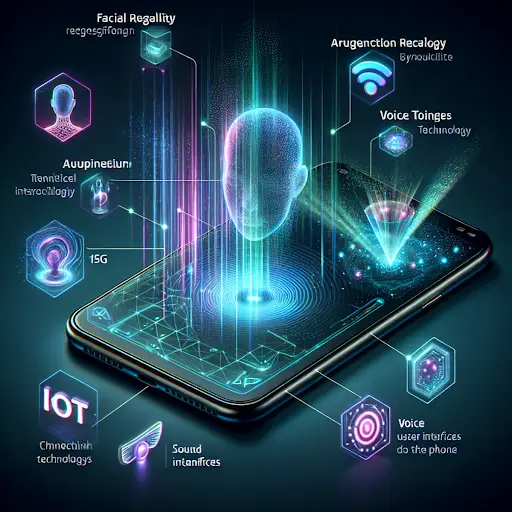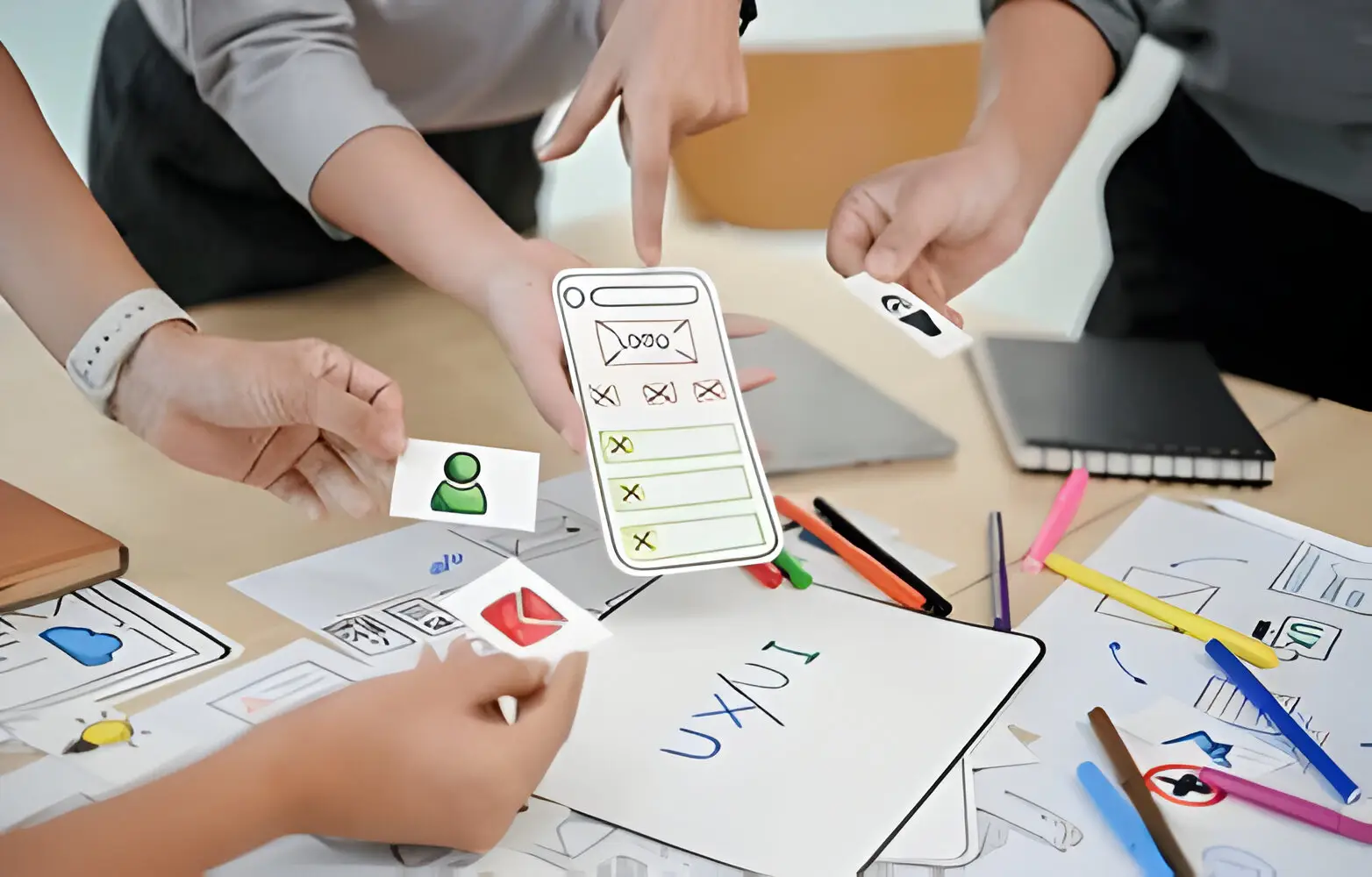
Mobile App Development
 Lets Talk
Lets Talk
The Future of Mobile Application Development: Trends and Predictions for 2024
By, Amy S
- 24 May, 2024
- 2.1k Views
- 0 Comment
The future of mobile application development is an exciting and rapidly evolving landscape. Staying updated with the latest trends is crucial for businesses and developers to remain competitive. Mobile app development services are continuously advancing, driven by technological innovations and changing user needs.
In 2024, several key trends are expected to shape the industry:
- AI-powered user experiences: Enhancing interactions through facial recognition, animated photo enhancements, secure online payments, and deep consumer behavior analysis.
- AR/VR expansion: Extending beyond gaming into social networks, interior design, education, and more.
- Voice User Interfaces (VUIs): Enabling seamless hands-free interactions and personalized customer support.
- IoT and Predictive Analytics: Delivering tailored experiences in healthcare and fintech.
- On-demand apps: Transforming industries like logistics with real-time resource management.
- 5G technology: Revolutionizing speed and connectivity while addressing security concerns.
- Cloud-driven mobile apps: Offering data accessibility across devices and scalability.
- Blockchain in mobile apps: Ensuring transparency and security in financial/supply chain applications.
- Edge computing: Enabling real-time processing and enhancing privacy/security.
- Quantum computing: Enhancing performance with superior computing capabilities.
1. AI-powered User Experiences
AI-powered user experiences are changing how users interact with mobile apps, making them more personalized and easy to use. This is made possible through the use of artificial intelligence (AI) technologies that can understand and interpret user preferences, behaviors, and intentions.Key Innovations in AI
Here are some examples of how AI is being used to create innovative user experiences in mobile apps:- Facial Recognition: This technology not only enhances security through biometric authentication but also offers convenience in-app access and personalization.
- Animated Photo Enhancements: Apps like Snapchat and Instagram leverage AI to animate photos, creating engaging content that resonates with users.
Enhancing Security and Personalization
- AI plays a crucial role in enhancing security for mobile transactions. Secure online payments use advanced algorithms to detect fraudulent activities, ensuring safer financial interactions.
- Additionally, through consumer behavior analysis, AI can understand user preferences better, tailoring experiences to individual needs. For example, e-commerce apps can recommend products based on past behavior, increasing user satisfaction and engagement.
Future Advancements
Looking ahead, we can expect AI to further improve mobile app experiences:- Emotion and Intention-based Commands: Voice assistants could interpret not just words but the user’s emotional state or intent, leading to more nuanced interactions.
- Deeper Behavioral Insights: Enhanced algorithms will offer even more precise predictions of user behavior, enabling hyper-personalized app experiences.
2. AR/VR Expansion
AR/VR expansion is pushing the boundaries of mobile app experiences beyond gaming into various sectors. Here are some examples:1. Social Networks
Imagine interacting with friends in a virtual space, attending virtual meetups, or exploring AR-enhanced profiles that bring social networking to life.2. Interior Design
Apps like Houzz and IKEA Place allow users to visualize furniture and decor in their homes through augmented reality, making interior design more accessible and fun.3. Education
AR/VR in education is transforming learning experiences. For example, students can take 3D historical journeys or access virtual science labs, making abstract concepts tangible and engaging.Virtual Clothing Try-On
Retailers are leveraging AR to offer virtual clothing try-on features. This allows customers to see how clothes look on them without physically trying them on, enhancing the online shopping experience.Transforming Industries
AR/VR technology is also making a significant impact in various industries:1. Travel
Virtual tourism experiences enable users to explore destinations from their homes, offering immersive previews before booking actual trips.2. Medicine
Medical consultations from home are becoming more interactive with VR technology. Patients can have detailed discussions with doctors and even undergo preliminary examinations virtually.3. Retail
The retail industry benefits from AR by providing customers with virtual fitting rooms and interactive product demos, increasing engagement and reducing return rates. The potential applications of AR/VR are vast, revolutionizing how we interact with digital content across numerous fields.3. Voice User Interfaces (VUIs)
Voice User Interfaces (VUIs) are changing how users interact with mobile apps by allowing them to use their voice instead of touch. With VUIs, you can navigate through an app, perform actions, and get information just by speaking commands.Examples of VUIs in Mobile Apps
Here are some common examples of how VUIs are used in mobile apps:- Virtual Assistants: Apps like Google Assistant and Siri allow users to set reminders, send messages, and search the web through voice commands.
- Smart Home Controls: Apps such as Amazon Alexa let you control smart home devices, from adjusting the thermostat to turning off lights, all via voice.
- Navigation: Voice-guided navigation in apps like Google Maps and Waze makes it easier for drivers to get directions without taking their eyes off the road.
Personalized Customer Support
VUIs can greatly improve customer support by offering personalized experiences:- Instant Solutions: Users can describe their issues verbally, and the app can provide immediate solutions or escalate the issue to a human agent.
- Tailored Responses: By analyzing user queries, VUIs can offer responses that are tailored to individual needs, creating a more engaging support experience.
- 24/7 Availability: Voice-based customer support can be available round-the-clock, ensuring that users get assistance whenever they need it.
4. IoT and Predictive Analytics
IoT and Predictive Analytics in mobile apps are changing many industries by using data-driven insights and immediate operational efficiency. In healthcare, for example, IoT devices make it easier to monitor patients from a distance, letting medical professionals keep track of vital signs and get notified about any irregularities. This proactive approach not only improves patient outcomes but also reduces the strain on hospitals. In fintech, predictive analytics plays a crucial role in detecting fraud. Mobile apps analyze user behavior patterns and transactional data to identify potential fraudulent activities. By using machine learning algorithms, these apps can offer secure financial transactions, building trust among users.Key Use Cases:
- Healthcare: Remote patient monitoring through IoT devices that track heart rate, blood pressure, and glucose levels.
- Fintech: Fraud detection via predictive analytics that analyzes transaction data for unusual patterns.
- Logistics: Tracking delivery vehicles in real-time to optimize routes and reduce fuel consumption.
- Smart Homes: Managing energy usage by monitoring connected devices such as thermostats and lights.
5. On-demand Apps
On-demand apps have made significant strides in transforming various industries, particularly logistics. These apps enable efficient, real-time service delivery that caters to the immediate needs of users. For example, crowd-sourced delivery services like Uber Eats and Postmates have revolutionized food delivery by connecting users with nearby couriers who can fulfill orders quickly.Logistics Transformation
On-demand logistics platforms streamline operations by:- Optimizing routes
- Managing inventory in real-time
- Reducing delivery times
Examples
Platforms like ShipBob and Flexe use on-demand services to provide warehousing solutions that adapt to fluctuating demands.Micro-interactions
Micro-interactions play a crucial role in enhancing user engagement within mobile app experiences. These subtle design elements create a more intuitive and enjoyable user experience by providing feedback, guiding tasks, and ensuring smooth transitions.Feedback and Guidance
Micro-interactions offer immediate feedback for user actions, such as button clicks or form submissions, which helps users understand the results of their actions.Enhancing Usability
They also guide users through complex processes with animations or brief instructions that make interactions feel seamless. Implementing well-designed micro-interactions can significantly increase user satisfaction and retention by making mobile apps more responsive and engaging.6. 5G Technology
The emergence of 5G technology is poised to greatly improve the speed and connectivity of mobile apps. With much lower delay and significantly faster data transfer rates, users will enjoy almost instant app responses and smooth streaming of videos and other media.Key Benefits of 5G for Mobile Apps
Here are some important advantages that 5G brings to mobile applications:- Ultra-fast speeds: This means you can have real-time conversations through video calls without any annoying delays.
- Low delay: This is crucial for apps that need immediate responses, like online gaming or virtual reality (VR) experiences.
- Better connection: With 5G, many more devices can stay connected at the same time, which opens up possibilities for more advanced Internet of Things (IoT) networks.
Security and Privacy Concerns
However, along with its benefits, the implementation of 5G technology also poses challenges when it comes to security and privacy. It’s important to take steps to safeguard user data by using strong encryption methods. Additionally, there is a need for updated regulations to address these new issues.Strategies to Address Security and Privacy Concerns in 5G
To tackle the security and privacy challenges that come with 5G, here are some strategies that can be employed:- End-to-end encryption: This ensures that data sent over 5G networks remains private and cannot be tampered with.
- Compliance with regulations: Following global standards and rules to protect user information across different countries.
- Effective detection of threats: Making use of cybersecurity tools driven by artificial intelligence (AI) to quickly identify and deal with potential dangers in real time.
7. Cloud-driven Mobile Apps
Cloud-driven mobile apps are changing the way we use technology by providing easy access to our data from anywhere and at any time. These apps store information on remote servers (known as the cloud), which means you can retrieve your files, photos, and other content using any device with an internet connection.Advantages of Cloud-driven Mobile Apps
Here are some key benefits of using cloud-driven mobile apps:- Data Accessibility Across Devices: Whether you’re using a smartphone, tablet, or computer, cloud-driven apps make it simple to access your files and information. You don’t have to worry about transferring data manually or being tied to a specific device.
- Scalability: Cloud infrastructure allows mobile apps to adjust their capacity according to user demand. This means that during busy periods, such as holidays or sales events, the app can handle a large number of users without slowing down or crashing.
8. Blockchain in Mobile Apps
Blockchain technology is a game-changer for transparency and security enhancement in mobile app development. By leveraging blockchain, apps can ensure data integrity and build trust among users, especially in sectors that require high levels of security like finance and supply chain management.Benefits of Blockchain in Financial Mobile Apps:
- Enhanced Security: Blockchain’s decentralized nature makes it extremely difficult for hackers to alter or manipulate data.
- Transparency: Every transaction is recorded on a public ledger, providing an immutable record that can be audited at any time.
- Efficiency: Smart contracts can automate and streamline financial operations, reducing the need for intermediaries.
Use Cases in Supply Chain Mobile Apps:
- Traceability: Blockchain enables end-to-end visibility of goods as they move through the supply chain, ensuring authenticity.
- Fraud Prevention: The transparent and immutable ledger helps prevent counterfeiting and fraud.
- Efficiency: Automating processes through smart contracts can reduce delays and increase operational efficiency.
9. Edge Computing
Edge computing is changing the way data is processed and managed in mobile apps. Instead of sending data to distant servers, edge computing brings the processing power closer to the source, whether it’s on the device itself or nearby servers. This enables mobile apps to perform tasks and analyze data instantly, without any delay.Why is Edge Computing Important for Mobile Apps?
Certain applications require immediate responses, and edge computing makes it possible:- Autonomous vehicles: Self-driving cars need to process large amounts of sensor data in real time to make split-second decisions on the road.
- Healthcare monitoring systems: Continuous monitoring of vital signs through wearable devices can alert medical professionals immediately if there are any abnormalities.
- Smart home devices: Connected devices like security cameras or voice assistants need to respond quickly to user commands or detect unusual activities.
Benefits of Edge Computing in Mobile Apps
Here are some advantages that edge computing brings to mobile app development:- Real-Time Processing: Data is processed locally on the device or nearby edge servers, reducing latency and ensuring swift responses.
- Enhanced Privacy/Security: With data processing occurring closer to the user, sensitive information doesn’t need to travel long distances to centralized cloud servers. This minimizes exposure to potential breaches and enhances data security.
- Reduced Bandwidth Usage: By processing data locally, less information needs to be transmitted over networks, leading to reduced bandwidth consumption and cost savings.
- Reliability: Even with intermittent internet connectivity, edge computing ensures that critical functionalities of mobile apps remain operational.
Examples of Edge Computing in Mobile Apps
Let’s take a look at how edge computing can be applied in specific industries:- Healthcare: Remote patient monitoring systems can analyze health data in real time to provide instant alerts and recommendations.
- Retail: Smart inventory management systems use edge computing to track stock levels and manage supply chains efficiently.
10. Quantum Computing
Quantum computing in mobile apps has the potential to completely transform how fast and powerful they are. Its advanced computing abilities allow mobile applications to handle complicated calculations incredibly quickly, pushing the limits of what can be done with real-time data processing. Here are some key ways quantum computing will impact mobile app development:- Enhanced Performance: Quantum computers can solve problems that are currently impossible for regular computers. This means faster algorithms for tasks like optimization, machine learning, and encryption.
- Quantum Encryption: Security is a big concern for mobile apps. Quantum encryption methods offer a higher level of security by using the principles of quantum mechanics to create unbreakable codes. This makes mobile transactions and sensitive data much safer from cyber threats.
- Advanced Simulations: Mobile apps that need complex simulations, such as those used in scientific research or financial modeling, can use quantum computing to get more accurate and quicker results.
- Improved AI Algorithms: Quantum computing makes AI even better by allowing more efficient training of complex models. This leads to smarter and more responsive mobile apps.
- Financial Apps: Using quantum algorithms to assess risks and optimize investment portfolios.
- Healthcare Apps: Applying quantum computations to model intricate biological processes for personalized medical treatments.
Embracing the Future: A Holistic Approach to Mobile App Development
Mobile app development is changing quickly. To keep up, it’s important to use a holistic approach that combines new technologies with methods that prioritize users. This way, apps can be both innovative and easy to use.Key Elements of a Holistic Approach
Here are two important parts of this approach:- Cutting-edge Technologies: Using new and powerful tools like AI, AR/VR, and IoT to build strong apps that will work well in the future.
- User-Centric Methodologies: Putting users first by focusing on what they want and involving them in the process of creating the app.
The Iterative Development Process
One effective way to create apps is through an iterative development process. This means:- Ongoing Feedback Collection: Regularly asking users for their thoughts and using that feedback to make improvements.
- Performance Measurement: Continuously checking how well the app is working and finding ways to make it faster or more reliable.
- Collaboration with Stakeholders: Working closely with everyone involved in the project (like designers, marketers, and business owners) to make sure everyone agrees on what the app should do.
Staying Curious and Adaptive
It’s important for developers to always be curious and willing to learn new things. This helps us stay ahead of trends and find better ways of doing things. We also need to think about important issues like privacy and making sure our apps are accessible to everyone. By doing this, we can create apps that not only look cool but also respect people’s rights. By following these ideas, developers can do a great job making mobile apps that people will love using.Conclusion
The future of mobile application development in 2024 is going to be game-changing. Trends like AI-powered user experiences, AR/VR expansion, Voice User Interfaces (VUIs), IoT and Predictive Analytics, on-demand apps, and 5G technology will completely transform how we use mobile apps. Cloud-based solutions, blockchain integration, edge computing, and quantum computing offer improved security, speed, and scalability. It’s crucial to embrace these trends in order to stay ahead. Use these advancements to create apps that are not only innovative but also focused on user needs and privacy. Digital Fractal can assist you in bringing your creative app concepts to life. Our extensive app development services ensure that your projects are constructed using future-proof technologies and the best practices of the industry. Ready to embrace the future of mobile app development? Contact us today!
Start your free consultation
Ready to discuss your project idea?
Category
- Android (12)
- Artificial Intelligence (49)
- Blockchain (10)
- Cloud Solutions (2)
- Cyber Security (3)
- Cybersecurity (8)
- Digital Transformation (72)
- Industry News (13)
- Infographics (10)
- iOS (4)
- Mobile App Development (99)
- Software (7)
- Uncategorized (46)
- Web development (15)
- Workflow Automation (4)
All Tag
Archives
- December 2025
- November 2025
- October 2025
- September 2025
- August 2025
- July 2025
- June 2025
- May 2025
- April 2025
- March 2025
- February 2025
- January 2025
- October 2024
- September 2024
- July 2024
- June 2024
- May 2024
- April 2024
- February 2024
- January 2024
- December 2023
- November 2023
- October 2023
- September 2023
- July 2023
- June 2023
- May 2023
- March 2023
- December 2022
- November 2022
- October 2022
- April 2022
- March 2021
- February 2021
- January 2021
- December 2020
- November 2020
- October 2020
- September 2020
- August 2020
- July 2020
- June 2020

